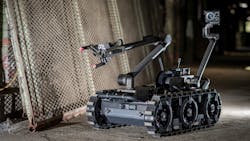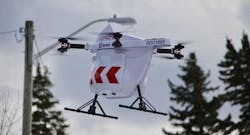FLIR Systems will deliver new unmanned ground vehicles to United States military
In this week’s roundup from the Association for Unmanned Vehicle Systems International, which highlights some of the latest news and headlines in unmanned vehicles and robotics, the United States Army and Navy order new unmanned ground vehicles, Drone Delivery Canada opens for business, and North Dakota establishes a network for beyond visual line of sight drone flights.
U.S. Army and Navy order more than 160 of FLIR Systems' Centaur UGVs
The U.S. Army and Navy have ordered more than 160 of FLIR Systems’ Centaur UGVs, plus related spares and accessories.
Totaling $23.5 million, the two contracts are being sourced through the Army’s Man Transportable Robotic System Increment II (MTRS Inc II) program. Deliveries are expected to begin in the third quarter of 2020.
“With the Navy joining the MTRS Inc II program, it means that all U.S. military forces will now use a common, medium-sized robotic platform for EOD and CBRN operations,” says Roger Wells, VP and general manager of the Unmanned Systems & Integrated Solutions business at FLIR.
“In an era of increased joint service operations in combat zones worldwide, having common equipment across EOD units can support more standardized tactics and techniques, plus add new efficiencies in sustainment and training for years to come.”
A medium-sized UGV, Centaur provides a standoff capability to detect, confirm, identify, and dispose of hazards. The open-architecture robot weighs approximately 160 pounds, and is equipped with an advanced EO/IR camera suite, a manipulator arm that reaches over six feet, and the ability to climb stairs. Modular payloads can be used for CBRNE detection and other missions.
Since March, FLIR has announced orders totaling more than $65 million for nearly 500 Centaur UGVs from several entities including the U.S. Air Force, Marine Corps, and now Navy. The UGVs will be used by Explosive Ordnance Disposal (EOD) teams to help disarm improvised explosive devices, unexploded ordnance, and similar hazardous tasks.
Different sensor and payloads can be quickly attached to the robot to support a variety of other functions including chemical, biological, radiological and nuclear (CBRN) missions.
The U.S. Army selected Endeavor Robotics in 2017 as its medium-sized robot provider for MTRS Inc II. Endeavor Robotics, which was acquired by FLIR in 2019, designed Centaur as its MTRS platform. Under that multi-year program of record, which upon award was valued at more than $150 million, including options, FLIR is delivering robots to the Army. These latest orders fall under the current ceiling.
Drone Delivery Canada launching UAS delivery service for Ontario's Beausoleil First Nation Community
With the assistance of Air Canada and the Pontiac Group, Drone Delivery Canada (DDC) has entered into a commercial agreement with The David McAntony Gibson Foundation (operating as GlobalMedic) to use its drone delivery technology to provide service to the Beausoleil First Nation Community (BFN) in Ontario.
A variety of donors provided funding for the project, including the OEC Group (Canada), which is a global logistics provider that services clients in all major industries including aerospace, healthcare, global retail, automotive and manufacturing.
“DDC and OEC have been looking for an opportunity to partner. When the chance popped up to help the Beausoleil First Nation community, it was an easy decision to make,” says Landon Bibeau, CMO of the OEC Group.
Under the terms of the Agreement, DDC will use its Sparrow drone and its DroneSpot takeoff and landing zones, as well as additional drone flight infrastructure as required, to enable a defined two-way delivery flight route from/to BFN mainland to/from the BFN Christian Island.
All operations will be conducted in accordance with the Canadian Aviation Regulations and Transport Canada flight authorizations. DDC will remotely monitor the flights from its new commercial operations center located in Vaughan, Ontario. DDC says that it will soon begin deployment of site infrastructure, and the company expects to begin providing drone delivery services under the Agreement in Q3 of 2020.
BFN will transport COVID-19 related cargo such as personal protection equipment (PPE), hygiene kits, test kits, and test swabs using DDC’s Sparrow drone, which will help limit person-to-person contact on its island ferry service.
The Agreement provides for the payment of an up-front, fixed fee for managed services for the project. The term of the Agreement is six months.
“To our knowledge this is the first announced COVID-19 related drone logistics project working with a humanitarian aid agency in Canada,” says Michael Zahra, president & CEO of DDC.
“The Beausoleil First Nation community will benefit from our drone delivery solution during the COVID-19 pandemic by limiting person-to-person contact between the mainland and Christian Island, while keeping their supply chain open.”
Collins Aerospace, L3Harris Technologies, Thales USA to help enable BVLOS UAS ops in North Dakota
Collins Aerospace, L3Harris Technologies, and Thales USA have all been selected to provide systems engineering and integration services to build, implement, and operate North Dakota’s first-of-its-kind, aviation-grade, statewide network for flying UAS beyond visual line of sight (BVLOS).
The companies have been contracted to work with the Northern Plains UAS Test Site (NPUASTS) to enable real-world, scalable, commercial and public BVLOS UAS operations in North Dakota.
“With this partnership in place, North Dakota is well-positioned to create and implement what is really the next level in the UAS industry,” says Nicholas Flom, executive director of the Northern Plains UAS Test Site, which administers the statewide UAS BVLOS network.
“Nobody else is doing what North Dakota is doing.”
In May 2019, the State of North Dakota made a $28 million investment in funding to support the creation of a statewide UAS network that would enable BVLOS flights to support operations across the state. By enabling UAS efficiencies for state and local agencies and commercial interests—both existing and future—the statewide network will facilitate economic growth opportunities in a variety of industries including agriculture, utilities, and public safety.
The first order that the system integrators have been tasked with is developing a BVLOS system development and implementation plan, with initial deployment in western North Dakota.
“We have multiple public and commercial use cases on the western side of the state, representing a variety of industries,” says Jim Cieplak, program manager for the statewide network at NPUASTS.
“This will enable the network to provide real-world benefits as we continue to build it out and expand its reach.”
Along with working to drive approvals from the FAA and the Federal Communications Commission (FCC), the companies will also support standards, policies, and procedures for UAS to be safely and efficiently integrated into the National Airspace System (NAS).
Compiled by Brian Sprowl, Associate Editor, AUVSI
Share your vision-related news by contacting Dennis Scimeca, Associate Editor, Vision Systems Design
SUBSCRIBE TO OUR NEWSLETTERS

